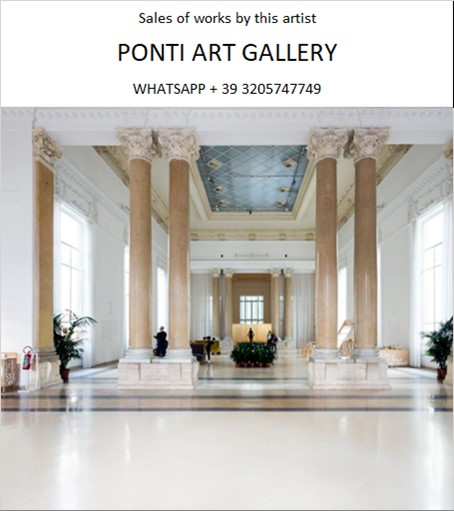Ponti Art Gallery is interested in buying and selling works
of art by this artist.

Ramkinkar Baij Biography
Ramkinkar Baij was a seminal figure in Indian art, widely regarded as one of the pioneers of modern Indian sculpture. His life and work were marked by a fierce independence and a profound connection to the rhythms of nature and the lives of the common people, particularly the Santhal tribe.
Born on May 25, 1906, in the small village of Bankura in West Bengal, Baij grew up in an economically modest family. Despite the financial constraints, his artistic talents manifested early on. As a young boy, he was drawn to the local craftsmen and image-makers, observing and learning from them, and creating small clay figures and paintings with whatever materials he could find.
At the age of 16, Baij's skill as an illustrator and artist caught the attention of the renowned journalist Ramananda Chatterjee, who recognized his potential and introduced him to Nandalal Bose at Kala Bhavana, the art school at Visva-Bharati University in Santiniketan, in 1925. This marked the beginning of a lifelong association with Santiniketan, where he was mentored by luminaries such as Nandalal Bose and Rabindranath Tagore.
Baij's time at Santiniketan was transformative. Under the guidance of Nandalal Bose, he honed his skills and developed a deep understanding of art. He was exposed to a variety of artistic traditions and modern European art movements, which influenced his work. Despite this exposure, Baij's style remained uniquely his own, characterized by a raw, expressive energy that was rooted in his observations of life around him.
His sculptures often depicted the lives of rural Indians, particularly the Santhals, a tribal community that lived on the outskirts of Santiniketan. Baij's work was marked by a robust realism, a departure from the idealized forms prevalent in Indian sculpture at the time. He worked with a variety of materials, including concrete and laterite pebbles, which were more affordable than traditional sculpting materials and lent his work a distinctive texture.
One of Baij's most famous works is the "Santhal Family," created in 1938, which depicts a tribal family moving with their belongings. The sculpture is celebrated for its dynamic composition and the dignified grace it imparts to its subjects. Baij's choice of cement and laterite mortar for this sculpture was innovative and radical for its time, as was his personal style that blended modern Western and Indian pre-classical sculptural values.
Throughout his career, Baij remained an iconoclast, often defying the artistic norms of his time. He was the first artist at Santiniketan to use oil paint and to create distinctly modern and abstract works. His paintings and sculptures were spontaneous and intuitive, reflecting his belief that art should be a direct expression of life.
Baij's contributions to Indian art were not limited to his own creations. He was also a dedicated teacher at Kala Bhavana, where he influenced a generation of artists. His notable disciples include Prabhas Sen, Shankho Chowdhury, and K.G. Subramanyan, among others.
Despite his significant contributions to Indian art, Baij lived a life of simplicity and was known for his almost saintly indifference to material comforts. His eccentric personality and love for cats were as much a part of his legend as his artistic genius.
Baij's work received national and international recognition. He was awarded the Padma Bhushan, one of India's highest civilian honors, in 1970. His legacy was further cemented by retrospectives of his work, including a major exhibition at the National Gallery of Modern Art in New Delhi in 2012.
Ramkinkar Baij passed away on August 2, 1980, in Kolkata, leaving behind a body of work that continues to inspire and influence artists around the world. His life and art were a testament to the power of creativity and the importance of staying true to one's vision and roots. Baij's sculptures and paintings remain a vital part of India's cultural heritage, embodying the spirit of innovation and the essence of Indian modernism.
Ramkinkar Baij Quotes and
Sales of Works
Ponti Art Gallery selects and deals with paintings by the
artist. Upon request, we provide free estimates and
evaluations, communicate prices, quotations, and current
market values.
If you are interested in BUYING or SELLING works by the
artist, contact us immediately.
If you wish to sell or receive an evaluation of the
works:
Send us a frontal photo of the painting, one of the back,
and one of the signature. Also, indicate the dimensions of
the work. Inform us about the purchase origin of the work
and any kind of available documentation (purchase
receipts, certificates of authenticity, publications). One
of our operators will respond to you on the same day. We
guarantee maximum confidentiality and extreme
professionalism.
If you wish to purchase works by the painter: Contact us
and let us know your request. We will inform you about the
available works. We also offer the possibility to
subscribe to our NEWSLETTER, through which you will be
informed at the beginning of each month about the latest
acquisitions of the art gallery.
You can send us pictures of the work:
